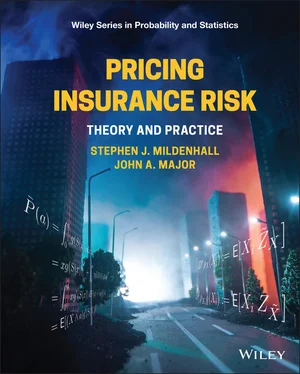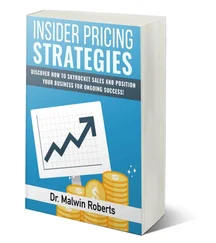Stephen J. Mildenhall - Pricing Insurance Risk
Здесь есть возможность читать онлайн «Stephen J. Mildenhall - Pricing Insurance Risk» — ознакомительный отрывок электронной книги совершенно бесплатно, а после прочтения отрывка купить полную версию. В некоторых случаях можно слушать аудио, скачать через торрент в формате fb2 и присутствует краткое содержание. Жанр: unrecognised, на английском языке. Описание произведения, (предисловие) а так же отзывы посетителей доступны на портале библиотеки ЛибКат.
- Название:Pricing Insurance Risk
- Автор:
- Жанр:
- Год:неизвестен
- ISBN:нет данных
- Рейтинг книги:4 / 5. Голосов: 1
-
Избранное:Добавить в избранное
- Отзывы:
-
Ваша оценка:
- 80
- 1
- 2
- 3
- 4
- 5
Pricing Insurance Risk: краткое содержание, описание и аннотация
Предлагаем к чтению аннотацию, описание, краткое содержание или предисловие (зависит от того, что написал сам автор книги «Pricing Insurance Risk»). Если вы не нашли необходимую информацию о книге — напишите в комментариях, мы постараемся отыскать её.
A comprehensive framework for measuring, valuing, and managing risk Pricing Insurance Risk: Theory and Practice
Pricing Insurance Risk: Theory and Practice
Pricing Insurance Risk — читать онлайн ознакомительный отрывок
Ниже представлен текст книги, разбитый по страницам. Система сохранения места последней прочитанной страницы, позволяет с удобством читать онлайн бесплатно книгу «Pricing Insurance Risk», без необходимости каждый раз заново искать на чём Вы остановились. Поставьте закладку, и сможете в любой момент перейти на страницу, на которой закончили чтение.
Интервал:
Закладка:
A long-tailedunit has a slow payout pattern, meaning claims are not settled until many years after they occur.
Reinsuranceis a type of insurance, so we say insurance to cover both, and reinsurance if that is all we mean. Ced ents cede business to reinsurers.
The accounting distinction between capital and equity causes unnecessary confusion.
Capitalrefers to funds intended to assure the payment of obligations from insurance contracts, over and above reserves for policyholder liabilities. Capital is also referred to as net assets. The book value of capital depends on accounting conventions. Capital is usually regulated by statute. Surplusis a synonym for capital used in US statutory accounts.
Equityis the value of the owner’s residual interest. In a stock company, it is called shareholder’s equity. Accounting equity is typically lower than capital since debt can be included in capital but not equity. Equity also has a market value for public stock companies, based on the value of shares outstanding. Equity levels are not regulated. Accounting equity can be negative. The market value of equity is always non-negative because of limited liability.
2.2 Ins Co.: A One-Period Insurer
In this section, we introduce the hypothetical insurer called Ins Co., that we use as the base for our theory and examples. Ins Co. is a limited liability company that intermediates between insureds and investors.
Ins Co.’s customers are insuredswho are subject to risks they wish to insure, for the three reasons explained in Section 8.1.1. Insureds who use insurance for risk transfer or financing are sensitive to insurer quality and possible default because it correlates with their own misfortune (Merton and Perold 1993; Froot 2007).
Ins Co. is owned by investorswho provide risk bearing capital. The investor group overlaps with the insured group in a mutual insurer. Investors may be risk averse. They often have limited capacity to evaluate insurance risk, giving insurers a competitive advantage in risk assessment and pricing (Froot and O’Connell 2008).
Ins Co. exists for one period. It comes into existence at time t = 0 and lasts for one period. Ins Co. has no initial liabilities. At t = 0 it writes one or more single-period insurance contracts and collects premiums from its insureds. At the same time, it raises capital from investors by selling them all or part of its uncertain t = 1 residual value. Ins Co.’s liabilities can be structured as a combination of equity, debt, or reinsurance.
When Ins Co. writes a policy, it collects premium at t = 0 and earns it over the period. We assume all other transactions occur at the end of the period. Therefore all the premium is earned and available to pay claims at t = 1. There is no need to consider an unearned premium reserve because there are no intermediate cash flows or solvency tests between t = 0 and t = 1.
At time t = 1, Ins Co. pays any claims due and gives any residual value to its investors. If Ins Co.’s assets are insufficient to pay the claims, then it defaults. Investors have limited liability: they lose their original investment but owe nothing more.
The length of the policy period is relevant because it determines the investors’ cost to fund the insurer. At t = 0 the investors must pay-in the capital, i.e., cause cash to be transferred into a separate legal entity. They may incur a time-based funding cost. Since funding costs are expressed per year, it is usual to use a one-year time period.
Premiums cover expected losses and loss adjustment expenses, the cost of capital, and frictional capital costs. All other expenses are outside the model. The epigraph to Section 1 shows that Adam Smith was already aware of the cost of capital for insurers in 1789, and wrote about it in a surprisingly modern manner.
Table 2.1summarizes the aggregate cash flows between Ins Co., investors, and policyholders. At t = 0 all amounts are fixed. At t = 1 the random loss outcome X is revealed. The model can include stochastic asset returns.
Table 2.1 Investor and insured transactions with Ins Co. at t=0,1. In the last row X∧a′=min(X,a′)
| View | Total | Loss | Margin | Capital | |||
|---|---|---|---|---|---|---|---|
| At issue, t = 0 | |||||||
| Insured | Premium | = | Expected loss cost | + | Margin | ||
| Investor | Capital | = | Capital | ||||
| Ins Co. Total | Assets | = | Expected loss cost | + | Margin | + | Capital |
| expected | a | = | E[X] | + | M | + | Q |
| At expiration, t = 1 | |||||||
| Ins Co. Total | Assets | = | Loss outcome | + | Residual value | ||
| random | a′=a(1+r) | = | X∧a′ | + | (a′−X)+ |
In an unregulated insurance market, insured relative risk aversion interacts with investor opportunity costs of capital to determine the amount of assets supporting the risk and the split of those assets into premium and capital. In a regulated market, the amount of assets is determined, or at least heavily influenced by a regulator (or quasi-regulatory rating agency), but the market still determines the split of funding between premium and equity.
2.3 Model vs. Reality
The reader should bear in mind:
Man plans, and God laughs (old Yiddish saying)
Anything that can go wrong, will go wrong (Edward Murphy)
The map is not the territory (Alfred Korzybski)
All models are wrong but some are useful (George E.P. Box)
All the analysis presented in this book presumes we know the objective probability distribution underlying the phenomenon being studied. Cue laughter. This conceit is particularly pernicious when coupled with management optimism and its attempts at optimization.
To make the results useful , sensitivity analysis must be part of the effort. Perturb the assumptions in a realistic manner and repeat the risk measure calibration, capital calculation, margin allocation, etc. Then do it again. Coherent risk measures are all about taking the worst case among a set of alternatives. The alternatives reflect our uncertainty about event probabilities by positing different values. Lift this strategy to the entire engagement. Generate a set of assumptions and look across the set of answers. Only then will you know whether the best estimate is robust or fragile. With that caveat, we proceed, assuming that we have a tin opener as the joke about economists has it.
2.4 Examples and Case Studies
In this section we introduce a Simple Discrete Example and three more realistic Case Studies. These are used throughout the book to illustrate the various methods presented in the theory chapters.
We include simple examples to familiarize practitioners with the computations required to implement the methods we cover. The Cases aim to help practitioners develop an intuition for how each method prices business, informing their selection of an appropriate method for an intended purpose without resorting to trial and error.
Читать дальшеИнтервал:
Закладка:
Похожие книги на «Pricing Insurance Risk»
Представляем Вашему вниманию похожие книги на «Pricing Insurance Risk» списком для выбора. Мы отобрали схожую по названию и смыслу литературу в надежде предоставить читателям больше вариантов отыскать новые, интересные, ещё непрочитанные произведения.
Обсуждение, отзывы о книге «Pricing Insurance Risk» и просто собственные мнения читателей. Оставьте ваши комментарии, напишите, что Вы думаете о произведении, его смысле или главных героях. Укажите что конкретно понравилось, а что нет, и почему Вы так считаете.












